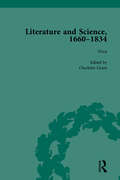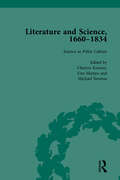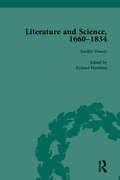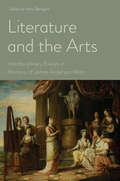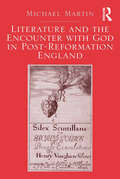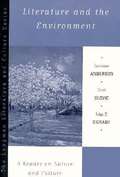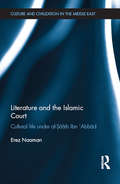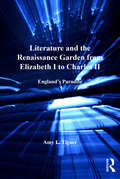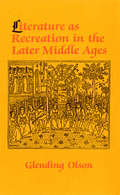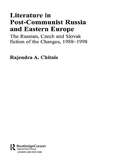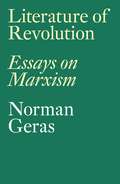- Table View
- List View
Literature and Science, 1660-1834, Part I, Volume 4
by Judith HawleyThis volume reproduces primary texts which embody the polymathic nature of the literature of science, and provides editorial overviews and extensive references, to provide a resource for specialized academics and researchers with a broad cultural interest in the long 18th century.
Literature and Science, 1660-1834, Part I. Volume 1
by Judith HawleyThis volume reproduces primary texts which embody the polymathic nature of the literature of science, and provides editorial overviews and extensive references, to provide a resource for specialized academics and researchers with a broad cultural interest in the long 18th century.
Literature and Science, 1660-1834, Part I. Volume 2
by Judith HawleyThis volume reproduces primary texts which embody the polymathic nature of the literature of science, and provides editorial overviews and extensive references, to provide a resource for specialized academics and researchers with a broad cultural interest in the long 18th century.
Literature and Science, 1660-1834, Part I. Volume 3
by Judith HawleyThis volume reproduces primary texts which embody the polymathic nature of the literature of science, and provides editorial overviews and extensive references, to provide a resource for specialized academics and researchers with a broad cultural interest in the long 18th century.
Literature and the Arts: Interdisciplinary Essays in Memory of James Anderson Winn
by David Hopkins Peter Sabor Amanda Eubanks Winkler Paul Hammond Steven N Zwicker Paula R. Backscheider Anna Battigelli Andrew Walkling Cedric D Reverand Ellen T Harris Melissa A SchoenbergerThe ten essays in Literature and the Arts explore the intermedial plenitude of eighteenth-century English culture, honoring the memory of James Anderson Winn, whose work demonstrated how seeing that interplay of the arts and literature was essential to a full understanding of Restoration and eighteenth-century English culture. Scenery, machinery, music, dance, and texts transformed one another, both enriching and complicating generic distinctions. Artists were alive to the power of the arts to reflect and shape reality, and their audience was quick to turn to the arts as performative pleasures and critical lenses through which to understand a changing world. This collection's eminent authors discuss estate design, musicalized theater, the visual spectacle of musical performance, stage machinery and set designs, the social uses of painting and singing, drama’s reflection of a transformed military infrastructure, and the arts of memory and of laughter.
Literature and the Encounter with God in Post-Reformation England: Literature And The Encounter With God In Post-reformation England, C. 1550--1704
by Michael MartinEach of the figures examined in this study”John Dee, John Donne, Sir Kenelm Digby, Henry and Thomas Vaughan, and Jane Lead”is concerned with the ways in which God can be approached or experienced. Michael Martin analyzes the ways in which the encounter with God is figured among these early modern writers who inhabit the shared cultural space of poets and preachers, mystics and scientists. The three main themes that inform this study are Cura animarum, the care of souls, and the diminished role of spiritual direction in post-Reformation religious life; the rise of scientific rationality; and the struggle against the disappearance of the Holy. Arising from the methods and commitments of phenomenology, the primary mode of inquiry of this study resides in contemplation, not in a religious sense, but in the realm of perception, attendance, and acceptance. Martin portrays figures such as Dee, Digby, and Thomas Vaughan not as the eccentrics they are often depicted to have been, but rather as participating in a religious mainstream that had been radically altered by the disappearance of any kind of mandatory or regular spiritual direction, a problem which was further complicated and exacerbated by the rise of science. Thus this study contributes to a reconfiguration of our notion of what ’religious orthodoxy’ really meant during the period, and calls into question our own assumptions about what is (or was) ’orthodox’ and ’heterodox.’
Literature and the Environment: A Reader on Nature and Culture (The Longman Literature and Culture Series)
by Lorraine Anderson Scott Slovic John P. O'GradyExploring our relationship to nature and the role literature can play in shaping a culture responsive to environmental realities, this thematic, multi-genre anthology includes early writers such as John Muir, Henry David Thoreau, and Mary Austin, alongside contemporary voices such a Gary Snyder and Terry Tempest Williams.
Literature and the Idea of Luxury in Early Modern England
by Alison V. ScottExploring the idea of luxury in relation to a series of neighboring but distinct concepts including avarice, excess, licentiousness, indulgence, vitality, abundance, and waste, this study combines intellectual and cultural historical methods to trace discontinuities in luxury’s conceptual development in seventeenth-century England. The central argument is that, as ’luxury’ was gradually Englished in seventeenth-century culture, it developed political and aesthetic meanings that connect with eighteenth-century debates even as they oppose their so-called demoralizing thrust. Alison Scott closely examines the meanings of luxury in early modern English culture through literary and rhetorical uses of the idea. She argues that, while ’luxury’ could and often did denote merely ’lust’ or ’licentiousness’ as it tends to be glossed by modern editors of contemporary works, its cultural lexicon was in fact more complex and fluid than that at this time. Moreover, that fuller understanding of its plural and shifting meanings-as they are examined here-has implications for the current intellectual history of the idea in Western thought. The existing narrative of luxury’s conceptual development is one of progressive upward transformation, beginning with the rise of economic liberalism amidst eighteenth-century debates; it is one that assumes essential continuity between the medieval treatment of luxury as the sin of ’luxuria’ and early modern notions of the idea even as social practises of luxury explode in early seventeenth-century culture.
Literature and the Islamic Court: Cultural life under al-Sahib Ibn 'Abbad (Culture and Civilization in the Middle East)
by Erez NaamanCourts were the most important frameworks for the production, performance, and evaluation of literature in medieval Islamic civilization. Patrons vying for prestige attracted to their courts literary people who sought their financial support. The most successful courts assembled outstanding literary people from across the region. The court of the vizier and literary person al-Sahib Ibn ʿAbbad (326-385/938-995) in western Iran is one of the most remarkable examples of a medieval Islamic court, with a sophisticated literary activity in Arabic (and, to a lesser extent, in Persian). Literature and the Islamic Court examines the literary activity at the court of al-Sahib and sheds light on its functional logic. It is an inquiry into the nature of a great medieval court, where various genres of poetry and prose were produced, performed, and evaluated regularly. Major aspects examined in the book are the patterns of patronage, selection, and auditioning; the cultural codes and norms governing performance, production, and criticism; the interaction between the patron and courtiers and among the courtiers themselves; competition; genres as productive molds; the hegemonic literary taste; and the courtly habitus. This book reveals the significance these courts held as institutions that were at the heart of literary production in Arabic. Using primary medieval Arabic sources, this book offers a comprehensive analysis of Islamic courts and as such is of key interest to students and scholars of Arabic literature, Islamic history and medieval studies.
Literature and the Renaissance Garden from Elizabeth I to Charles II: England’s Paradise (Literary And Scientific Cultures Of Early Modernity Ser.)
by Amy L. TignerSpanning the period from Elizabeth I's reign to Charles II's restoration, this study argues the garden is a primary site evincing a progressive narrative of change, a narrative that looks to the Edenic as obtainable ideal in court politics, economic prosperity, and national identity in early modern England. In the first part of the study, Amy L. Tigner traces the conceptual forms that the paradise imaginary takes in works by Gascoigne, Spenser, and Shakespeare, all of whom depict the garden as a space in which to imagine the national body of England and the gendered body of the monarch. In the concluding chapters, she discusses the function of gardens in the literary works by Jonson, an anonymous masque playwright, and Milton, the herbals of John Gerard and John Parkinson, and the tract writing of Ralph Austen, Lawrence Beal, and Walter Blithe. In these texts, the paradise imaginary is less about the body politic of the monarch and more about colonial pursuits and pressing environmental issues. As Tigner identifies, during this period literary representations of gardens become potent discursive models that both inspire constructions of their aesthetic principles and reflect innovations in horticulture and garden technology. Further, the development of the botanical garden ushers in a new world of science and exploration. With the importation of a new world of plants, the garden emerges as a locus of scientific study: hybridization, medical investigation, and the proliferation of new ornamentals and aliments. In this way, the garden functions as a means to understand and possess the rapidly expanding globe.
Literature as Recreation in the Later Middle Ages
by Glending OlsonThis book studies attitudes toward secular literature during the later Middle Ages. Exploring two related medieval justifications of literary pleasure—one finding hygienic or therapeutic value in entertainment, and another stressing the psychological and ethical rewards of taking time out from work in order to refresh oneself—Glending Olson reveals that, contrary to much recent opinion, many medieval writers and thinkers accepted delight and enjoyment as valid goals of literature without always demanding moral profit as well.Drawing on a vast amount of primary material, including contemporary medical manuscripts and printed texts, Olson discusses theatrics, humanist literary criticism, prologues to romances and fabliaux, and Chaucer's Canterbury Tales. He offers an extended examination of the framing story of Boccaccio's Decameron. Although intended principally as a contribution to the history of medieval literary theory and criticism, Literature as Recreation in the Later Middle Ages makes use of medical, psychological, and sociological insights that lead to a fuller understanding of late medieval secular culture.
Literature in Dialogue with the Natural Sciences: Competing Claims from the Early Modern Period to the 20th Century
by Christoph StrosetzkiThe thesis of the book is that in the early modern period, literature claimed precedence over the observation of nature. There were shifts through phases of temporary parity, the priority of natural sciences in the 19th century, and their critique by literature in the 20th century. These developments are presented in France and the Spanish-speaking world, while also considering Germany and England: While Montaigne, Pedro Mexía, Pérez de Oliva, Vives, and Gracián prioritize literature, Pascal contrasts the "esprit de finesse" with the "esprit de géométrie," opening a controversy that Linnaeus and Buffon continue. Enlightenment thinkers like Voltaire orient themselves toward the English model, where Locke and Hume introduce empirical sciences whose advances Rousseau critiques. In the 19th century, Balzac and Pérez Galdós engage with the natural sciences, with Zola later looking to Darwin and Comte as role models. Finally, the aporias of scientific thinking are highlighted by Ortega y Gasset, Borges, and Sábato.
Literature in Post-Communist Russia and Eastern Europe: The Russian, Czech and Slovak Fiction of the Changes 1988-98 (BASEES/Routledge Series on Russian and East European Studies)
by Rajendra Anand ChitnisThis book considers Russian, Czech and Slovak fiction in the late communist and early post-communist periods. It focuses on the most innovative trend to emerge in this period, on those writers who, during and after the collapse of communism, characterised themselves as 'liberators' of literature. It shows how these writers in their fiction and critical work reacted against the politicisation of literature by Marxist-Leninist and dissident ideologues, rejecting the conventional perception of literature as moral teacher, and redefining the nature and purpose of writing. The book demonstrates how this quest, enacted in the works of these writers, served for many critics and readers as a metaphor for the wider disorientation and crisis precipitated by the collapse of communism.
Literature of Girmitiya: History, Culture and Identity
by Neha Singh Sajaudeen ChapparbanThis book covers various forms of the production of girmitiya culture and literature. One of the main objectives is to conceptualize the idea of girmitya, girmitology, and girmitiya literature, culture, history, and identity in both colonial and postcolonial contexts. This book aims to document the history, experiences, culture, assimilation, and identity of girmitiya community. It also critically analyses the articulation, projection, and production of their experiences of migration and being immigrant, their narratives, tradition, culture, religion, and memory. It also explores how this labour community formulated into a diaspora community and reconnected/created the home (land) and continues to do so in the wake of globalization and Information and Communication Technology (ICT). This book is an attempt to bring the intriguing neglected diverse historical heritage of colonial labour migration and their narratives into the mainstream scholarly debates and discussions in the humanities and the social sciences through the trans- and interdisciplinary perspectives. This book assesses the routes of migration of old diaspora, and it explains the nuances of cultural change among the generations. Although, they have migrated centuries back, absorbed and assimilated, and got citizenships of respective countries of destinations but still their longing for roots, culture, identities, “home”, and the constant struggle is to retain connections with their homeland depicted in their cultural practices, arts, music, songs, folklore and literary manifestations.
Literature of Revolution: Essays on Marxism
by Norman GerasThis influential collection explores the pivotal texts and topics in the Marxist tradition. Ranging over questions of social theory, political theory, moral philosophy and literary criticism, it looks at the thought of Marx and Trotsky, Luxemburg, Lenin and Althusser. Included here are Geras’s influential and widely cited treatment of fetishism in Capital, his comprehensive review of debates on Marxism and justice, discussions on political organization, revolutionary mass action and party pluralism, and a novel analysis of the literary power of Trotsky’s writing.
Literature of the Holocaust
by Alan RosenDuring and in the aftermath of the dark period of the Holocaust, writers across Europe and America sought to express their feelings and experiences through their writings. This book provides a comprehensive account of these writings through essays from expert scholars, covering a wide geographic, linguistic, thematic and generic range of materials. Such an overview is particularly appropriate at a time when the corpus of Holocaust literature has grown to immense proportions and when guidance is needed in determining a canon of essential readings, a context to interpret them, and a paradigm for the evolution of writing on the Holocaust. The expert contributors to this volume, who negotiate the literature in the original languages, provide insight into the influence of national traditions and the importance of language, especially but not exclusively Yiddish and Hebrew, to the literary response arising from the Holocaust.
Literature, American Style: The Originality of Imitation in the Early Republic
by Ezra TawilBetween 1780 and 1800, authors of imaginative literature in the new United States wanted to assert that their works, which bore obvious connections to anglophone literature on the far side of the Atlantic, nevertheless constituted a properly "American" tradition. No one had yet figured out, however, what it would mean to write like an American, what literature with an American origin would look like, nor what literary characteristics the elusive quality of Americanness could generate. Literature, American Style returns to this historical moment—decades before the romantic nationalism of Cooper, the transcendentalism of Emerson and Thoreau, or the iconoclastic poetics of Whitman—when a fantasy about the unique characteristics of U.S. literature first took shape, and when that notion was linked to literary style.While late eighteenth-century U.S. literature advertised itself as the cultural manifestation of a radically innovative nation, Ezra Tawil argues, it was not primarily marked by invention or disruption. In fact, its authors self-consciously imitated European literary traditions while adapting them to a new cultural environment. These writers gravitated to the realm of style, then, because it provided a way of sidestepping the uncomfortable reality of cultural indebtedness; it was their use of style that provided a way of departing from European literary precedents. Tawil analyzes Noah Webster's plan to reform the American tongue; J. Hector St. John de Crèvecoeur's fashioning of an extravagantly naïve American style from well-worn topoi; Charles Brockden Brown's adaptations of the British gothic; and the marriage of seduction plots to American "plain style" in works such as Susanna Rowson's Charlotte Temple and Hannah Webster Foster's The Coquette. Each of these works claims to embody something "American" in style yet, according to Tawil, remains legible only in the context of stylistic, generic, and conceptual forms that animated English cultural life through the century.
Literature, Electricity and Politics 1740–1840: ‘Electrick Communication Every Where’ (Palgrave Studies in Literature, Science and Medicine)
by Mary FaircloughThis book investigates the science of electricity in the long eighteenth century and its textual life in literary and political writings. Electricity was celebrated as a symbol of enlightened progress, but its operation and its utility were unsettlingly obscure. As a result, debates about the nature of electricity dovetailed with discussions of the relation between body and soul, the nature of sexual attraction, the properties of revolutionary communication and the mysteries of vitality. This study explores the complex textual manifestations of electricity between 1740 and 1840, in which commentators describe it both as a material force and as a purely figurative one. The book analyses attempts by both elite and popular practitioners of electricity to elucidate the mysteries of electricity, and traces the figurative uses of electrical language in the works of writers including Mary Robinson, Edmund Burke, Erasmus Darwin, John Thelwall, Mary Shelley and Richard Carlile.
Literature, Ethics, and Aesthetics
by Sabrina AchillesA conceptualization of the literary aesthetic for a concern for the Self. Bringing Gilles Deleuze and Felix Guattari's constructivist thinking into a practical domain, Sabrina Achilles rethinks the ways in which literature is understood and taught.
Literature, Journalism and the Avant-Garde: Intersection in Egypt (Routledge Studies in Middle Eastern Literatures)
by Elisabeth KendallThe author explores the role of journalism in Egypt in effecting and promoting the development of modern Arabic literature from its inception in the mid-nineteenth century to the present day. Remapping the literary scene in Egypt over recent decades, Kendall focuses on the independent, frequently dissident, journals that were the real hotbed of innovative literary activity and which made a lasting impact by propelling Arabic literature into the post-modern era.
Literature, Language, and the Rise of the Intellectual Disciplines in Britain, 1680–1820
by Robin ValenzaThe current divide between the sciences and the humanities, which often seem to speak entirely different languages, has its roots in the way intellectual disciplines developed in the long eighteenth century. As various fields of study became defined and to some degree professionalized, their ways of communicating evolved into an increasingly specialist vocabulary. Chemists, physicists, philosophers, and poets argued about whether their discourses should become more and more specialized, or whether they should aim to remain intelligible to the layperson. In this interdisciplinary study, Robin Valenza shows how Isaac Newton, Samuel Johnson, David Hume, Adam Smith, Samuel Taylor Coleridge and William Wordsworth invented new intellectual languages. By offering a much-needed new account of the rise of the modern disciplines, Robin Valenza shows why the sciences and humanities diverged so strongly, and argues that literature has a special role in navigating between the languages of different areas of thought.
Literature, Religion, and the Evolution of Culture, 1660–1780
by Howard D. WeinbrotA distinguished critic traces the growing, but always threatened, trend toward political and religious tolerance from the mid-seventeenth to the late eighteenth century in Britain.Winner of the CHOICE Outstanding Academic Title of the Choice ACRLLiterature, Religion, and the Evolution of Culture, 1660–1780 chronicles changes in contentious politics and religion and their varied representations in British letters from the mid-seventeenth to the late eighteenth century. An uncertain trend toward tolerance and away from painful discord significantly influenced authors who reflected on and enhanced germane aspects of British literary and intellectual life. The movement was stymied during the painful Gordon Riots in June 1780, from which Britain needed to repair itself.Howard D. Weinbrot's broad-ranging interdisciplinary study considers sermons, satire, political and religious polemic, Anglo-French relations, biblical and theological commentary, Methodism, legal history, and the novel. Literature, Religion, and the Evolution of Culture, 1660–1780 analyzes the texts and contexts of several major and minor authors, including Daniel Defoe, Charles Dickens, Olaudah Equiano, Maria De Fleury, Lord George Gordon, Nathaniel Lancaster, Henry Sacheverell, Tobias Smollett, and Edward Synge.
Literature, the Gothic and the Reconstruction of History: The Past as Nightmare
by Neil Cocks Daniel Renshaw AndIn the Gothic, nothing stays buried for long. Since its inception in the mid-eighteenth century, the Gothic imagination has been concerned with the pasts of the societies from which it emerged. This collection, featuring contributions from archivists, historians and literary critics, examines how horror fiction and the wider Gothic mode have engaged with the constructed conception of "history".From Victorian nightmares of Jurassic jungles to ghost stories on the contemporary stage, the contributors adopt varied and innovative approaches to consider how the Gothic has created, complicated and sometimes subverted historical narratives. In doing so, these works blur the distinctions between the "historical record" and creative endeavour, undermine linear and sequential understandings of the progress of time and dissolve temporal boundaries. The collection explores a variety of Gothic forms including drama, poetry, prose, illustration, film and folklore, and it draws on classic texts such as Wuthering Heights and Dracula, as well as less familiar works, including Reynolds’ The Mysteries of London and Baldini’s Mal’aria.Literature, the Gothic and the Reconstruction of History will be invaluable to students and scholars interested in the confluences of literary and historical endeavour, the creation and depiction of historical constructs in popular culture, and Gothic horror in its myriad forms.
Literature: Timeless Voices, Timeless Themes (The American Experience)
by Prentice HallIf you had been one of the early explorers or settlers of North America, you would have found many things in your new environment unknown to you. The handiest way of filling voids in your vocabulary would have been to ask local Native Americans what words they used. The early colonists began borrowing words from friendly Native Americans almost from the moment of their first contact, and many of those shared words have remained in our everyday language.
